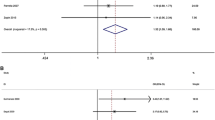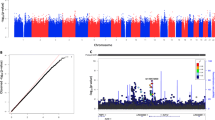Abstract
The aim of the study is to investigate the association of several single-nucleotide polymorphisms (SNPs) within Toll-like receptors (TLRs) gene and additional gene–gene and gene–human papillomavirus (HPV) infection interaction with cervical cancer risk. A total of 1262 participants are selected, including 420 cervical cancer patients and 842 control participants. Generalized multifactor dimensionality reduction (GMDR) was used to screen the best interaction combination among five SNPs within TLR gene and HPV infection. Logistic regression was performed to calculate the ORs (95 %CI) for association of five SNPs within TLR gene and additional gene–HPV infection interaction with cervical cancer risk. Cervical cancer risk was significantly higher in carriers of the T allele of rs3775290 within TLR2 gene, the G allele of rs7873784 within TLR4 gene, and the A allele of rs352140 within TLR9 gene than those with wild genotype; adjusted ORs (95 %CI) were 1.78 (1.20–2.24), 1.65 (1.23–2.12), and 1.70 (1.16–2.31). However, we did not find any significant association of rs4986791 and rs11536889 with cervical cancer risk. GMDR analysis suggested a significant two-locus model (p = 0.0107) involving rs352140 and HPV infection. Subjects with HPV infection and rs352140-GA + AA genotype within TLR9 gene have the highest cervical cancer risk, compared to no HPV infection participants with rs352140-GG genotype, OR (95 %CI) = 3.22 (1.68–4.81). Pairwise LD analysis did not find any significant haplotype combination associated with cervical cancer risk. The minor alleles of TLR2-rs3775290, TLR4-rs7873784, and TLR9-rs352140, and interaction between rs352140 and HPV infection were all associated with increased cervical cancer risk.

Similar content being viewed by others
References
Aderem A, Ulevitch RJ (2000) Toll-like receptors in the induction of the innate immune response. Nature 406(6797):782–787
Akira S, Takeda K (2004) Toll-like receptor signalling. Nat Rev Immunol 4:499–511
Behtash N, Mehrdad N (2006) Cervical cancer: screening and prevention. Asian Pac J Cancer Prev 7(4):683–686
Cannella F, Pierangeli A, Scagnolari C, Cacciotti G, Tranquilli G, Stentella P, Recine N, Antonelli G (2015) TLR9 is expressed in human papillomavirus-positive cervical cells and is overexpressed in persistent infections. Immunobiology 220:363–368
Chen X, Wang S, Liu L, Chen Z, Qiang F, Kan Y, Shen Y, Wu J, Shen H, Hu Z (2012) A genetic variant in the promoter region of toll-like receptor 9 and cervical cancer susceptibility. DNA Cell Biol 31:766–771
Clark K (2014) Protein kinase networks that limit TLR signalling. Biochem Soc Trans 42:11–24
Daud II, Scott ME, Ma Y, Shiboski S, Farhat S, Moscicki AB (2011) Association between toll-like receptor expression and human papillomavirus type 16 persistence. Int J Cancer 128:879–886
DeCarlo CA, Rosa B, Jackson R, Niccoli S, Escott NG, Zehbe I (2012) Toll-like receptor transcriptome in the HPV-positive cervical cancer microenvironment. Clin Dev Immunol 2012:785–825
Jemal A, Bray F, Center MM, Ferlay J, Ward E, Forman D (2011) Global cancer statistics. CA Cancer J Clin 61(2):69–90
Kawasaki T, Kawai T (2014) Toll-like receptor signaling pathways. Front Immunol 5:461
Liao SF, Lee WC, Chen HC, Chuang LC, Pan MH, Chen CJ (2012) Baseline human papillomavirus infection, high vaginal parity, and their interaction on cervical cancer risks after a follow-up of more than 10 years. Cancer Causes Control 23(5):703–708
Lou XY, Chen GB, Yan L, Ma JZ, Zhu J, Elston RC, Li MD (2007) A generalized combinatorial approach for detecting gene-by gene and gene-by-environment interactions with application to nicotine dependence. Am J Hum Genet 80(6):1125–1137
Medzhitov R (2001) Toll-like receptors and innate immunity. Nat Rev Immunol 1:135–145
Mu X, Zhao J, Yuan X, Zhao X, Yao K, Liu Y, Zhao X (2015) Gene Polymorphisms of toll-like receptor 9-1486T/C and 2848G/A in cervical cancer risk. Int J Gynecol Cancer 25(7):1173–1178
Opal SM, Esmon CT (2003) Bench-to-bedside review: Functional relationships between coagulation and the innate immune response and their respective roles in the pathogenesis of sepsis. Crit Care 7:23–38
Pandey S, Mittal RD, Srivastava M, Srivastava K, Singh S, Srivastava S, Mittal B (2009) Impact of toll-like receptors [TLR] 2(–196 to –174 del) and TLR 4 (Asp299Gly, Thr399Ile) in cervical cancer susceptibility in north Indian women. Gynecol Oncol 114:501–505
Pandey S, Mittal B, Srivastava M, Singh S, Srivastava K, Lal P, Mittal RD (2011) Evaluation of toll-like receptors 3 (1377C/T) and 9 (G2848A) gene polymorphisms in cervical cancer susceptibility. Mol Biol Rep 38(7):4715–4721
Ronco G, Meijer CJ, Cuzick J, Giorgi-Rossi P, Peto J, Segnan N, Dillner J (2012) Screening for cervical cancer. Ann Intern Med 156(8):604–605
Roszak A, Lianeri M, Sowin’ska A, Jagodzin’ski PP (2012) Involvement of toll-like receptor 9 polymorphism in cervical cancer development. Mol Biol Rep 39:8425–8430
Shepherd JH (1995) FIGO staging of gynecologic cancers; cervical and vulva. Int J Gynecol Cancer 5:319
Takeda K, Kaisho T, Akira S (2003) Toll-like receptors. Annu Rev Immunol 21:335–376
Xu Q, Xue F, Yuan B, Zhang L, Li J, He Z (2012) The interaction between RAGE gene polymorphisms and HPV infection in determining the susceptibility of cervical cancer in a Chinese population. Cancer Biomark 11(4):147–153
Zidi S, Verdi H, Yilmaz-Yalcin Y, Yazici AC, Gazouani E, Mezlini A, Atac FB, Yacoubi-Loueslati B (2014) Involvement of Toll-like receptors in cervical cancer susceptibility among Tunisian women. Bull Cancer 101(10):E31–E35
Zidi S, Sghaier I, Gazouani E, Mezlini A, Yacoubi-Loueslati B (2016) Evaluation of toll-like receptors 2/3/4/9 gene polymorphisms in cervical cancer evolution. Pathol Oncol Res 22(2):323–330
Acknowledgements
We thank the investigators and staffs from the First Affiliated Hospital of Harbin Medical University, and all the partners and staffs who help us in the process of this study.
Author information
Authors and Affiliations
Corresponding author
Ethics declarations
Conflict of interest
The author(s) declare that they have no conflict of interests.
Rights and permissions
About this article
Cite this article
Jin, Y., Qiu, S., Shao, N. et al. Association of toll-like receptor gene polymorphisms and its interaction with HPV infection in determining the susceptibility of cervical cancer in Chinese Han population. Mamm Genome 28, 213–219 (2017). https://doi.org/10.1007/s00335-017-9691-x
Received:
Accepted:
Published:
Issue Date:
DOI: https://doi.org/10.1007/s00335-017-9691-x




